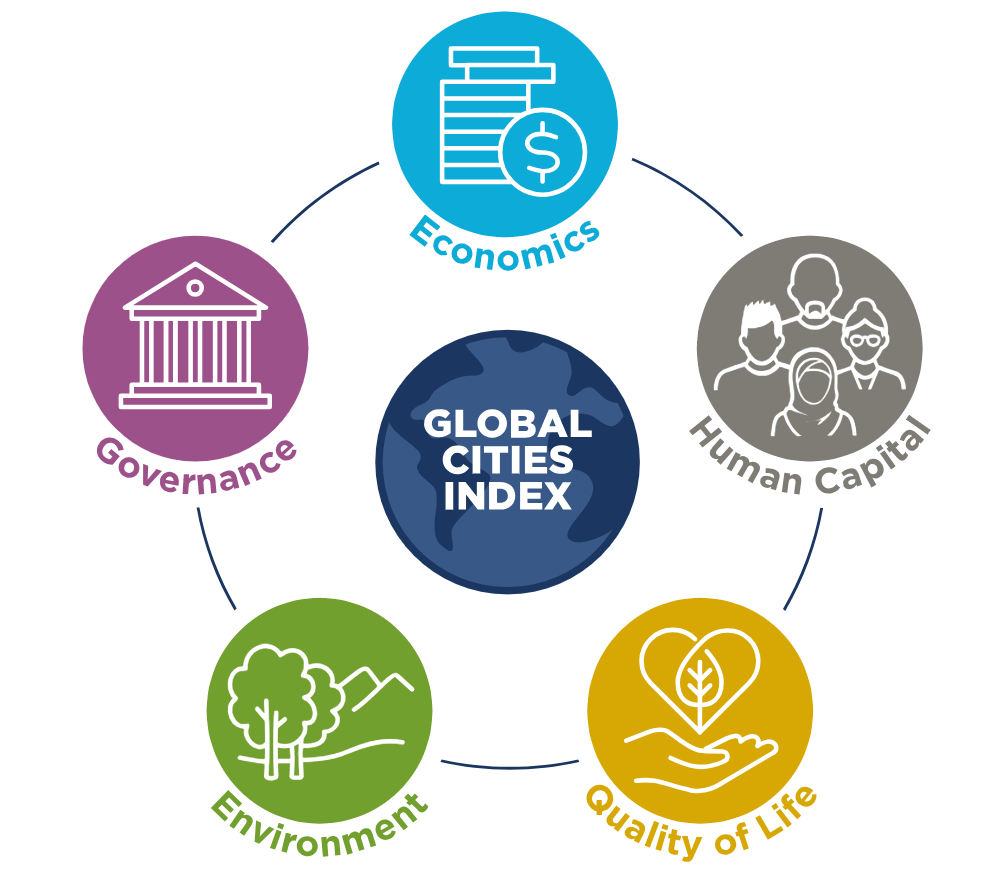Global Cities Index (original) (raw)
Oxford Economics’ Global Cities Index ranks the top cities in the world based on five categories: Economics, Human Capital, Quality of Life, Environment and Governance.

Covering the largest 1,000 cities in the world, our index provides a consistent framework for assessing the strengths and weaknesses of urban economies.
Key Findings
- The top 10 cities in the 2024 Global Cities Index are located on four continents. The diversity in characteristics of these cities emphasises that there is no single formula for leading the pack.
- Across the 1,000 cities, those in North America, Western Europe and Oceania generally perform best, scoring highly across all categories.
- But even within regions, there is significant variation across cities. A few of the top cities in Sub-Saharan Africa outperform the weakest cities in Western Europe.
Want to download this report?
Click here to fill out our simple form
Get my Report
In 2023, the 1,000 largest cities in the world accounted for 60% of global GDP and over 30% of the world’s population—and the importance of cities will only continue to grow in the future.
Click image to enlarge
Overall Scores
Assessing the relative strengths and importance of cities around the world is valuable for businesses, academics and policymakers alike to be able to make informed decisions. Such comparisons must consider more than just economic performance. Our Global Cities Index contains five categories: Economics, Human Capital, Quality of Life, Environment and Governance, which are aggregated to create an overall score for each city.
How we score and rank the 1,000 largest cities globally
The overall scores are calculated based on 27 indicators across our five categories. Our best-in-class economic forecasts underpin these rankings, supplemented by additional publicly available datasets. By analysing these five dimensions in depth, the Global Cities Index provides unparalleled insights into the multifaceted nature of urban environments worldwide.

Economics
A city’s economy plays a crucial role in its prosperity and attractiveness. Economic vitality is a fundamental aspect of urban development, driving a city’s wealth generation, employment opportunities, access to goods and services and much more. Our Economics category allows for an assessment of a city’s potential for sustained growth and development.
How we score and rank the 1,000 cities in the Economics category
In the Economics category we assess the economic size, structure, and growth of each city, examining both historical performance and future potential. The indicators we use are:
- GDP size
- GDP growth
- GDP per person
- Employment growth
- Economic stability
- Economic diversity
Human Capital
Human capital encompasses the collective knowledge and skills of a city’s population, underpinning the economic potential of every city. It reflects the dynamics of educational attainment, innovation, and demographics at play across metropolitan areas. In today’s knowledge-based economy, cities with diverse, highly-skilled workforces and innovative businesses are better positioned to adapt to technological change and compete globally.
How we score and rank the 1,000 cities in the Human Capital category
In the Human Capital category we assess the educational and business climates of each city, in conjunction with demographic trends. The indicators we use are:
- Educational attainment
- Universities
- Corporate headquarters
- Population growth
- Age profile
- Foreign-born population
Quality of Life
Quality of life encapsulates the wellbeing and satisfaction of a city’s residents, reflecting the intersection of various socioeconomic factors. This category provides insights into the liveability and attractiveness of a city, which can play a role in migration patterns, talent retention and the overall happiness of residents.
How we score and rank the 1,000 cities in the Quality of Life category
In the Quality of Life category we assess the benefits of living in each city and residents’ wellbeing, covering financial and health outcomes, as well as access to amenities. The indicators we use are:
- Life expectancy
- Income per person
- Income equality
- Housing expenditure
- Recreation & cultural sites
- Internet speed
Environment
With climate change at the forefront of international, national, and urban policymaking, the relevance of this category is undeniable. The Environment category evaluates a city’s commitment to environmental sustainability and its predisposition to climate change risks; environmental sustainability is critical for ensuring long-term resilience.
How we score and rank the 1,000 cities in the Environment category
In the Environment category we assess the natural environment of each city on climate change-related issues. The indicators we use are:
- Air quality
- Emissions intensity
- Natural disasters
- Temperature anomalies
- Rainfall anomalies
Governance
Governance is the basic foundation for city prosperity across the other four categories. Good governance fosters trust, social cohesion, and equitable access to opportunities, while poor governance can lead to inefficiencies, corruption, and social unrest.
Scores in the Governance category are calculated at the national level rather than the city level, meaning that every city in a given country is given the same score for a given indicator.
How we score and rank the 1,000 cities in the Governance category
In the Governance category we assess measure the political stability of a city and the degree to which residents’ rights are protected. The indicators we use are:
- Institutions
- Political stability
- Business environment
- Civil liberties
Register now for our on-demand webinar
Book a demo to explore the Global Cities Index Dashboard
To support location decision-making and strategic planning, we have developed a dashboard that allows you to delve deeper into the data for the largest 1,000 cities globally. To trial our dashboard and cities services, please fill in the form.
Need further support? Let us know in the comments field.
Learn more about our cities services and capabilities
Share
symbol/arrow LEFTsymbol/arrow RIGHTPathFill 1Combined Shapeicon-arrow-lefticon-arrow-rightPathRectanglePathicon calendarPathPathicon-circle-playClose IconEmailShapeExternal iconFacebookInstagramLinkedInShapeicon-mouseTelephoneShapeicon-pinterestPlay iconProfile icon??PathShapeIconPathicon-twitterWe Chaticon-youtubeLogo_OxEc